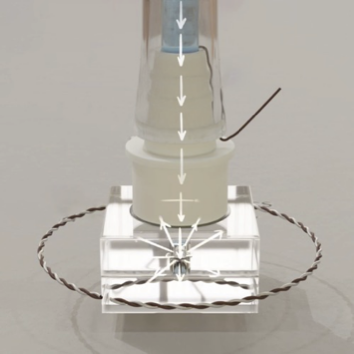Design of highly charged liquid-solid interfaces for new energy technologies
Research project of Amina Saidi, student of the Soft Nanoscience program of GS@UGA, at the LiPhy, Grenoble.
Electrolytes at solid interfaces play a major role in supercapacitors, batteries, fuel cells, but also for harvesting the "blue energy" of saline gradients.
Electrolytes at solid interfaces play a central role in the energy transition, not only for electricity storage (supercapacitors, batteries, fuel cells) but also for energy conversion. In particular, the osmotic energy also called «blue energy» is a promising low-carbon, non-intermittent source of energy with a global potential of 1 TW (~ 1000 nuclear reactors), but its large-scale harvesting has so far been limited because of the low efficiency of the membranes used. However, recent findings of ultra-high performances of single nanofluidic objects, such as nanotubes or nanopores in ultra-thin materials, have shown that considerable progress could be made with a better fundamental understanding of the physics of nanoconfined electrolytes [1].
Two physical phenomena are absolutely central in these applications: the accumulation of counter-ions on charged surfaces in solution, and the generation of hydrodynamic, electric or ionic fluxes by pressure, potential or concentration gradients (electrokinetic couplings). A fundamental question is to determine how these phenomena are piloted by the electrical charge of the solid surfaces in solution [2]. From a more applicative point of view, this will allow to identify promising physicochemical systems for new energy technologies.
The objective of this internship is to fabricate and characterize solid substrates developing large surface charges in solution. The proposed strategy will consist in covering glass substrates with BN, TiO2 or MoS2 coatings, semiconductors that are able to provide large electrical charges to the surface when in contact with aqueous electrolytes [3]. The nanometric films with be deposited with a magnetron sputtering machine. Topography will be evaluated by atomic force microscopy. Surface charge will be deduced from electro-osmotic measurements performed with an original set-up developed in our team.
References
[1] A. Siria, P. Poncharal, A.-L. Biance, R. Fulcrand, X. Blase, S. T. Purcell and L. Bocquet, “Giant osmotic energy conversion measured in a single transmembrane boron nitride nanotube”, Nature 494, 455-458 (2013)
[2] R. Hartkamp, A.-L. Biance, L. Fub, J.-F. Dufrêche, O. Bonhomme and L. Joly, “Measuring surface charge: Why experimental characterization and molecular modeling should be coupled”, Curr. Opin. Colloid Interface Sci. 37, 101-114 (2018)
[3] A. Siria, M.-L. Bocquet and L. Bocquet, “New avenues for the large-scale harvesting of blue energy”, Nat. Rev. Chem., 1, 0091 (2017)
Published on February 20, 2024
Updated on September 4, 2024
